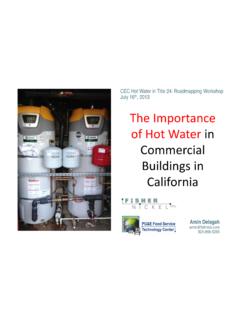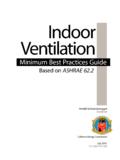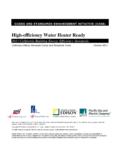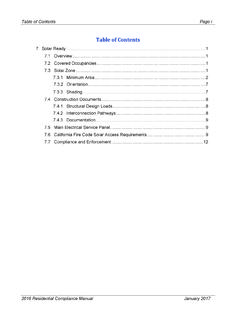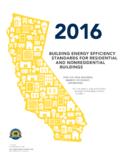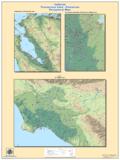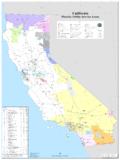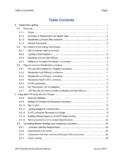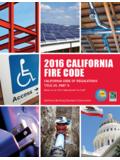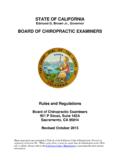Transcription of BUILDING ENERGY EFFICIENCY STANDARDS
1 2013. BUILDING ENERGY . EFFICIENCY STANDARDS . For Residential and Nonresidential Buildings Title 24, Part 6 and Associated Administrative Regulations in Part 1. MAY 2012. CEC 400 2012 004-CMF-REV2. california ENERGY COMMISSION. Edmund G. Brown Jr., Governor John Laird Secretary for Natural Resources Agency california ENERGY COMMISSION: Robert Weisenmiller, Chairman Commissioners: Andrew McAllister Karen Douglas, David Hochschild Janea A. Scott, Robert P. Oglesby Executive Director David Ashuckian Deputy Director EFFICIENCY and Renewable ENERGY Division Bill Pennington Deputy Division Chief EFFICIENCY and Renewable ENERGY Division Eurlyne Geiszler Office Manager High Performance Buildings Office Project Managers: Maziar Shirakh, High Performance Buildings Office (This page left intentionally blank).
2 ERRATA HISTORY The Revised 2013 BUILDING ENERGY EFFICIENCY STANDARDS for Residential and Nonresidential Buildings to be effective on July 1, 2014 now include the following ENERGY Commission approved and adopted Nonsubstantive errata: - Nonsubstantial Errata November 2013. - Nonsubstantial Errata - September 2013. - Supplement to Nonsubstantial Errata - December 2012. - Nonsubstantive Errata - May 2012. (This page left intentionally blank). ABSTRACT. Public Resources code Sections 25402 and were enacted in 1975 as part of the enabling legislation establishing the california ENERGY Commission and its basic mandates. These sections require the ENERGY Commission to adopt, implement, and periodically update ENERGY EFFICIENCY STANDARDS for both residential and nonresidential buildings.
3 The STANDARDS must be cost effective based on the life cycle of the BUILDING , must include performance and prescriptive compliance approaches, and must be periodically updated to account for technological improvements in EFFICIENCY technology. Accordingly, the california ENERGY Commission has adopted and periodically updated the STANDARDS (codified in Title 24, Part 6 of the california code of Regulations) to ensure that BUILDING construction, system design and installation achieve ENERGY EFFICIENCY and preserve outdoor and indoor environmental quality. The STANDARDS establish a minimum level of BUILDING ENERGY EFFICIENCY . A BUILDING can be designed to a higher EFFICIENCY level, resulting in additional ENERGY savings.
4 The 2013 BUILDING ENERGY EFFICIENCY STANDARDS focus on several key areas to improve the ENERGY EFFICIENCY of newly constructed buildings and additions and alterations to existing buildings, and include requirements that will enable both demand reductions during critical peak periods and future solar electric and thermal system installations. The most significant EFFICIENCY improvements to the residential STANDARDS are proposed for windows, envelope insulation and HVAC system testing. The most significant EFFICIENCY improvements to the nonresidential STANDARDS are proposed for lighting controls, windows, unitary HVAC equipment and BUILDING commissioning. New EFFICIENCY requirements for process loads such as commercial refrigeration, data centers, kitchen exhaust systems and compressed air systems are included in the nonresidential STANDARDS .
5 The 2013 STANDARDS include expanded criteria for acceptance testing of mechanical and lighting systems, as well as new requirements for code compliance data to be collected in a california ENERGY Commission managed repository. The 2013 STANDARDS also include updates to the ENERGY EFFICIENCY divisions of the california Green BUILDING code STANDARDS (Title 24, Part 11). A set of prerequisites has been established for both the residential and nonresidential Reach STANDARDS , which include EFFICIENCY measures that should be installed in any BUILDING project striving to meet advanced levels of ENERGY EFFICIENCY . The residential Reach STANDARDS have also been updated to require additional ENERGY EFFICIENCY or on site renewable electricity generation to meet a specific threshold of expected electricity use.
6 Both the residential and nonresidential Reach STANDARDS include requirements for additions and alterations to existing buildings. ENERGY Commission staff estimates that the implementation of the 2013 BUILDING ENERGY EFFICIENCY STANDARDS may reduce statewide annual electricity consumption by approximately 613 gigawatt hours per year, electrical peak demand by 195 megawatts, and natural gas consumption by 10 million therms per year. The potential effect of these ENERGY savings to air quality may be a net reduction in the emission of nitric oxide by approximately 59 tons per year, Acknowledgments The BUILDING ENERGY EFFICIENCY STANDARDS ( STANDARDS ) were first adopted and put into effect in 1978. and have been updated periodically in the intervening years.
7 The STANDARDS are a unique california asset and have benefitted from the conscientious involvement and enduring commitment to the public good of many persons and organizations along the way. The 2013 STANDARDS development and adoption process continued that long-standing practice of maintaining the STANDARDS with technical rigor, challenging but achievable design and construction practices, public engagement and full consideration of the views of stakeholders. The 2013 STANDARDS revision and the supporting documents were conceptualized, evaluated and justified through the excellent work of ENERGY Commission staff and consultants working under contract to the ENERGY Commission, Pacific Gas and Electric Company, Southern california Edison Company, San Diego Gas and Electric Company, and Southern california Gas Company.
8 At the ENERGY Commission, Maziar Shirakh, ; and Martha Brook, served as the project managers and senior engineers. Bill Pennington, Deputy Division Chief of the EFFICIENCY and Renewable ENERGY Division, provided overall guidance to the staff and consultants. Eurlyne Geiszler served as the Office Manager for the High Performance Buildings Office. Pippin Brehler and Kristen Driskell provided legal counsel to the staff. Other key technical staff contributors included, Gary Flamm;. Patrick Saxton ; Jeff Miller, ; Payam Bozorgchami, ; David Ware; Tav Commins; Rob Hudler; Owen Howlett; Danny Tam; and Nelson Pena. Additional staff input and assistance came from Ron Yasny; Seran Thamilseran; Brian Samuelson; Chris Olvera; Jim Holland; Todd Ferris; Joe Loyer, Alan Marshall; the ENERGY Hotline staff; and the ENERGY Commission's Web Team.
9 Key ENERGY Commission and CASE consultants included Architectural ENERGY Corporation, Bruce Wilcox, Taylor Engineering, Proctor Engineering, Benya Lighting Design, Chitwood ENERGY Management, Davis ENERGY Group, EnerComp, McHugh ENERGY , ENERGY Solutions, E3, PECI, and the Heschong Mahone Group. The authors are grateful to the many people and organizations that contributed to the development and production of the STANDARDS and the supporting documents. The documents reflect, to a large extent, the comments made by the many people who took time to carefully review earlier versions. Reviewers who significantly contributed to the content include members of CABEC and CALBO. Special thanks go to Panama Bartholomy, the former Deputy Director EFFICIENCY and Renewable ENERGY Division for his vision and support of the 2013 STANDARDS .
10 The ENERGY Commission dedicates the adoption of the 2013 BUILDING ENERGY EFFICIENCY STANDARDS to Valerie T. Hall, (November 28, 1952 - December 21, 2010), Deputy Director of the EFFICIENCY and Renewable ENERGY Division for her more than 32. years of dedication to excellence in the development and implementation of ENERGY EFFICIENCY programs in california with the most aggressive ENERGY efficient BUILDING STANDARDS in the country and for being a model for others to follow. sulfur oxides by tons per year, carbon monoxide by 41 tons per year and particulate matter less than microns in diameter by 10 tons per year. Additionally, ENERGY Commission staff estimates that the implementation of the 2013 STANDARDS may reduce statewide carbon dioxide equivalent emissions by 215 thousand metric tons per year.
